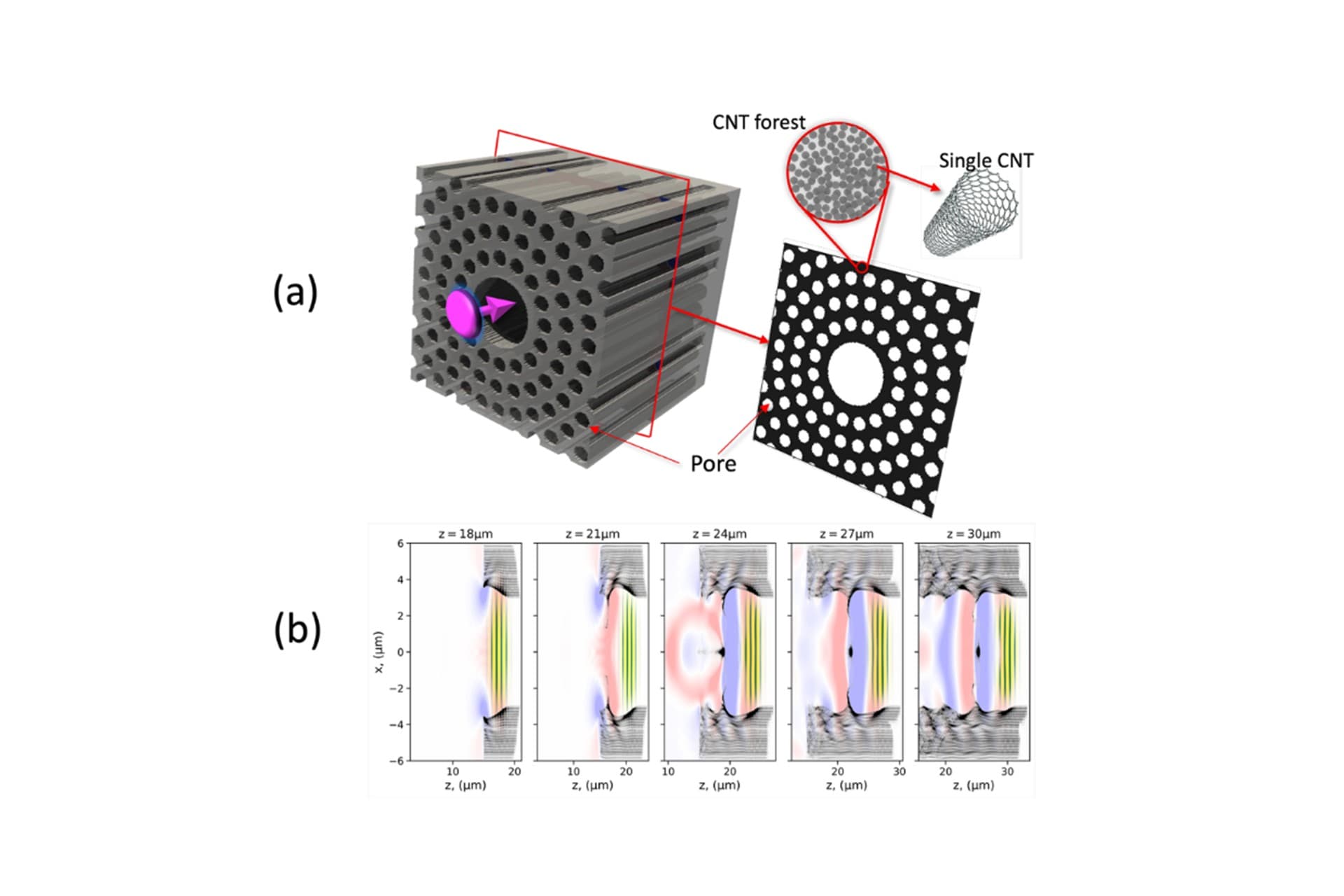Significant step toward achieving solid-state plasma-based wakefield acceleration

A recent paper published in Plasma Physics and Controlled Fusion, led by QUASAR Group member Bifeng Lei, has proposed a new method to generate TV/m-level electromagnetic (EM) fields for both positively and negatively charged particle acceleration by using relativistic surface plasmons (RSPs) excitation on the cylindrical surface of structured carbon nanotubes (CNTs)-based microtarget. This research is paving the way for the next generation of ultrahigh-gradient, ultra-compact accelerators.
Surface plasmons (SPs) are collective electron oscillations confined at the interface of conducting (e.g. crystal) and dielectric (e.g. vacuum) materials, which can also support TV/m-scale EM fields when driven appropriately. The strong EM fields offer opportunities to enhance and optimise the EM fields for electron acceleration, high harmonic generation and synchrotron radiation. However, the EM field of SPs on metal planar surfaces decays exponentially in the normal direction, limiting their effective range and posing challenges for efficient relativistic particle trapping and acceleration.
Moreover, there are still major challenges with traditional metals - they struggle to handle intense energy due to their electrical, thermal, mechanical, and optical limits. It's also difficult to create the complex surfaces needed to efficiently excite surface plasmons. Because of this, conventional materials aren't well-suited for reliably accelerating ultra-fast, single-energy electron beams and have limited practical use.
The paper has demonstrated the new solutions with the sharp, smooth surfaces inherent to carbon nanotubes, where the surface plasmons can exist under strong field excitation. The bound electrons can be ionised and simultaneously accelerated to be relativistic in a strong EM field, making initial material properties primarily influence only the ionisation process. As a result, surface plasmons behave in a new way - called the relativistic surface plasmon (RSP) regime - where their behaviour is mainly controlled by powerful, fast-moving (relativistic), and nonlinear plasma effects at the surface.
Carbon nanotubes offer alternative methods in supporting the efficient excitation of RSPs over other types of solids, such as amorphous, polycrystalline, or single-crystal solids. Their excellent thermal and electronic properties, well-defined structure, structural uniformity over large areas, high damage thresholds and tailorable geometry make them ideal platforms for generating and investigating the strong field RSPs in highly controlled ways. CNT-based RSP has critical implications for field confinement, energy transfer, and particle acceleration.
These new approaches can bypass propagation issues in the bulk and conventional SPs by allowing the driver beam to travel parallel in a dielectric medium (e.g. vacuum) while interacting intensely with the high-density plasma at the CNM-based solid surface to support up to 100s of TV/m wakefield fields and, at the same time, ensure stable and sustainable operation. As a result, this micro plasma accelerator can deliver ultrahigh-energy (e.g. TeV) electron beams or 10s of MeV attoseconds (as) electron beams of a narrow energy spectrum and high charge. Crucially, it is surface-dependent, where strong RSPs and their wakefield can be excited on planar and cylindrical surfaces, but are significantly different due to the varying surface geometries. This feature offers a unique method for extreme EM field and ultrashort beam generation and manipulation.
This research represents a significant step toward achieving solid-state plasma-based wakefield acceleration. The simulation results lay the groundwork for future experimental demonstration.
The full paper can be found here: https://iopscience.iop.org/article/10.1088/1361-6587/ade00a
* Image credit: Bifeng Lei et al 2025 Plasma Phys. Control. Fusion 67 065036, 4. CC BY 4.0